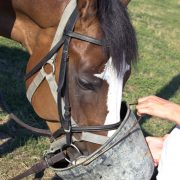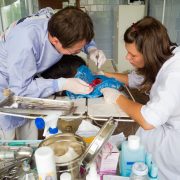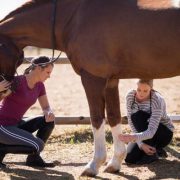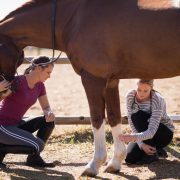Review of the role of biofilms in equine wounds: Clinical indications and treatment strategies
Review of the role of biofilms in equine wounds: Clinical indications and treatment strategies

our summary:
Marchant, K., Hendrickson, D.A. and Pezzanite, L.M. (2023) Review of the role of biofilms in equine wounds: Clinical indications and treatment strategies. Equine Veterinary Education. https://doi.org/10.1111/eve.13919
The aim of this review was to summarise the current evidence on the role of bacterial biofilms in the persistence of equine wounds, clinical indications of the involvement of biofilms, laboratory testing to improve biofilm detection and biofilm–based wound care treatment strategies.
Information is provided on the role of biofilms in wounds with discussion of the predisposing factors to wound infection and biofilm formation and strategies to prevent biofilm development in acute wounds. These strategies include wound debridement and cleansing to reduce bacterial counts and appropriate use of advanced dressings and topical antimicrobial agents.
Laboratory testing for, and clinical indications of, the presence of biofilms are considered with discussion of the various options available and their limitations. The authors then discuss the steps to take once the presence of biofilms in the wound is identified, these include the prompt implementation of a multimodal biofilm-based wound-care (BBWC) therapeutic approach .
BBWC strategies emphasise the importance of combining debridement, lavage and application of topical surfactants or antimicrobials within four hours of debridement. As the purpose of debridement is to disturb the biofilm structure and prevent bacterial reattachment, debridement should be carried out daily, or at least every other day, as mature biofilms can reform within 24-72 hours.
Finally the review discusses the mode of action and clinical significance of currently available antibiofilm products including surfactants and dressings. It then considers innovative approaches to combating biofilm infection, where the evidence base is still at an early stage, such as low-frequency ultrasound, phototherapy and lasers, and energy-based technologies, and the new treatment options and diagnostic techniques that are currently being investigated.
This review paper provides an overview of the current evidence on the role of biofilms in equine wound healing. It highlights the importance of prompt recognition of clinical indicators for biofilm and implementation of a multimodal biofilm-based wound care strategies and provides guidelines that will assist practitioners with case management.
The following may also be of interest:
inFOCUS: BEVA primary care clinical guidelines: Wound management in the horse [RCVS Knowledge] [online] Available from: https://infocus.rcvsknowledge.org/beva-primary-care-clinical-guidelines-wound-management-in-the-horse/ [Accessed 16 February 2024]
Claiming CPD for reading inFOCUS articles
Reading and reflecting on articles can count towards your CPD, and we have a template to help you with the process.
Image copyright attribute: edu1971










Leave a Reply
Want to join the discussion?Feel free to contribute!